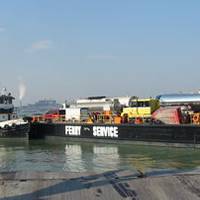Navigating Obstacles: Short Sea Shipping

Short-sea shipping, also referred to as the “Marine Highway” and, in some cases, “coastal shipping,” is the subject of more studies than we can list. Whatever the label, the concept refers to an initiative to get freight off our roadways, which are at capacity, and onto our waterways, which have to yet to be tapped to their potential. More than likely you’ve heard about the promises of this mode of transport, including reduced highway congestion, reduced consumption of fuel and fewer emissions per unit shipped. So what’s the hold up?
Floating Rail Bridge Between U.S. and Mexico
CG Railway, Inc., located in Mobile, Ala., operates the only rail vessel service in the United States market providing an alternate transportation mode between the U.S. and southern Mexico. Every four days, CG Railway provides a safe, fast and eco-friendly rail-ferry service transporting all types of rail cars to and from Mobile, Ala. and Coatzacoalcos, Veracruz. CG Railway’s direct service provides competitive rates with fast reliable transit. The faster transit secures additional savings to the supply chain through optimum equipment utilization and lower inventory carry cost. Each of CG Railway’s two rail ferries have the capacity to carry 115 standard rail cars and travels only 900 miles by sea as opposed to 1,400 miles via the traditional Mexican–U.S. border crossings.
CG Railway Finishes RoRo Conversion
Measuring 585-ft., the self-propelled RoRo sister vessels Bali Sea and Banda Sea completed shipyard conversion work in January for operation out of Mobile, Ala. by CG Railway. The vessels will be used for CG's new four-day interline rail-ferry service to transport freight in railcars between Mobile and Coatzacoalos, Mexico. Terminal facilities for this operation are in the final stages of completion. Each vessel has the capacity to hold 60 railcars, and each has unique 30-ft. high sidewalls to protect the railcars from sea water. Developed to provide another entry/exit system for the Canadian -Eastern U.S.-Mexico trade that will give railroads predominantly operating east of the Mississippi River direct and fast access to southeast and central Mexico.





